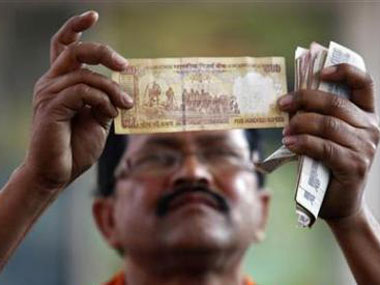The rupee’s downward spiral against the US dollar could spell good news for the domestic IT-ITeS sector, which has been facing strong headwinds due to a weak global economy, provided the Indian currency’s softening continues.
A stronger dollar boosts the sales of software firms in rupee terms as most of the software firms derive over half their revenues from the US. Little wonder that the The S&P BSE IT Index has gained about 8.6 percent since April 30, 2013.
“Rupee depreciation will impact IT and off-shore service providers in a positive way if it sustains for a longer period say for this quarter. It will help in expanding their margins to a certain extent,” Gartner Research Director Arup Roy said.
 Reuters[/caption]
Reuters[/caption]According to a report in the Economic Times, the rupee has fallen around 6.5 percent since April, which if sustained until the end of the quarter, could translate into a 180-240 basis point boost to the operating profit margins of Indian IT companies. But IT companies are unlikely to take full advantage of the weakening rupee and pass on the benefits of currency fluctuations to clients in order to gain an edge over rivals in a competitive business environment.
Moreover, given the currency hedging by IT companies, the rupee’s gains are unlikely to accrue immediately.
TCS and Wipro have relatively higher hedges and hence are not expected to see full benefits of rupee depreciation in the near term. In contrast, Infosys and HCL Tech’s hedging strategy should aid their profitability, a Business Standard report pointed out.
Impact Shorts
More ShortsAt 11:20 a.m,shares of Tata Consultancy Services (TCS) rose 0.5 percent, while Infotech Enterprises was up 3 percent. Wipro was down half a percent, while Infosys was up half a percent. Hexaware Technologies was up 0.3 percent. The broader BSE Sensex was down over 200 points at 19219.
However, depreciation in the Indian currency, which fell to a life-time low of 58.85 against the dollar today could lead to a rise in input costs for handset makers who see their margins eroded by the fall and could be forced to pass on the burden to the consumer, in case the situation persists.
“There is really a disadvantage for mid-tier and low-tier handsets makers who are importing into India because at that level the price sensitivity to the device price is very high and with the recent depreciation of the rupee that is having a direct impact on retail prices of imported handsets. “And at low and mid-tier, it’s likely to have an impact on sales because of the elasticity of demand at that level, PwC India Leader Telecom Mohammad Chowdhury said.
Chowdhury said it is less likely to impact smartphones because the price sensitivity is little less, but added, “I would say that in longer term if Rupee remains depreciated then there might be an upside benefit for Indian handset manufacturers with respect to exporting to other emerging markets.”
Even power generating companies, telcos and cement makers are likely to be big losers because they have sizeable forex loan exposure and no recourse to hedges.
A host of companies, especially infrastructure and metal firms, led by Reliance Communications, down 6.53 %, Adani Power and Tata Power, down 3.31 %, JSW Steel, down 4.14 % and state-owned SAIL, down 2.06%, that have significant foreign currency borrowings will be hurt by an adverse movement of the rupee against the US dollar or other major currencies, another ET report pointed out .
Meanwhile, oil marketing companies are also set to lose from a depreciating rupee as oil prices in rupee terms put pressure on their finances.
“In the past 20 days, while crude prices in dollar terms have remained stable at $101 per barrel, the price of the Indian oil basket has jumped 3.5% to Rs.5,751.83 a barrel. That points to increasing under-recoveries, or losses on selling fuel below cost, for these firms, " a Mint report pointed out.
With the rupee nearing 59 to a dollar, the under recoveries are set to increase by at least Rs 30,00 0 crore. Shares of BPCL were down 3 percent, Hindustan Petroleum 5.6 percent and Indian Oil Corp 1.92 percent.
On the other hand, a plunging rupee is a blessing in disguise for companies like RIL as it bills gas consumers in dollars. Even Oil and Natural Gas Corporation is in the business of producing oil and gas and the rupee devaluation should have worked to its advantage but for the subsidy burden it bears.
Among other energy companies, **Cairn India’**s margins are likely to go up by 90 basis points. **Aban Offshore’**s margins are likely to go up by 102 basis points, while Essar Oil margins may go up by 100 basis points tracking rupee weakness.
Pharma too stands to gain as a majority of its income is generated in international markets. For Sun Pharma, US constituted around 54 pe cent of the gross sales in fiscal 12-13. Another pharma major Dr Reddy’s receives 45 percent of its revenue from the North American market.
With inputs from PTI
)